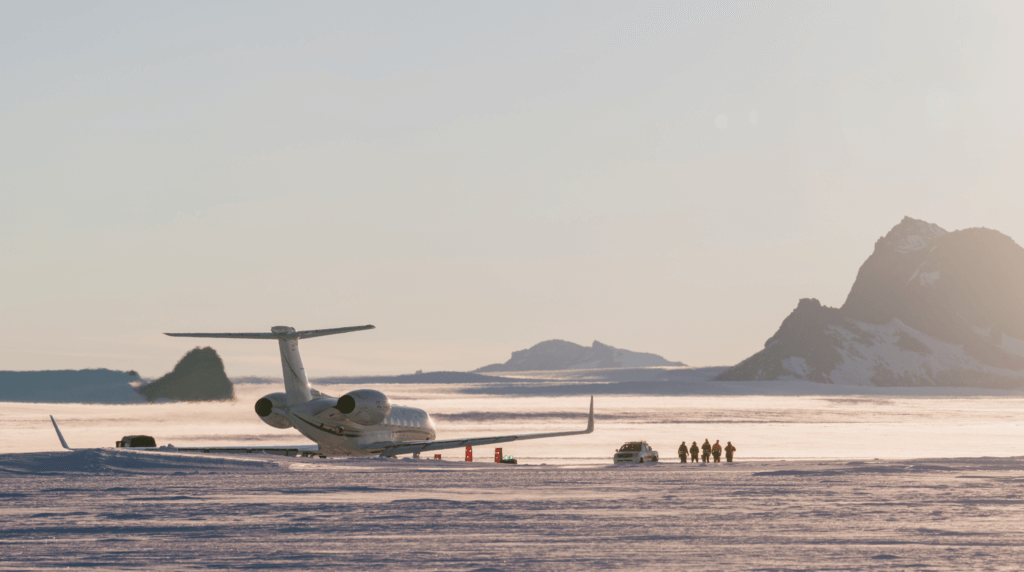How we land aircraft on a blue ice runway in Antarctica
Pre-flight checks by Wolf’s Fang Weather team for a landing in Antarctica
You can be sure that before the Airbus-340 taxies down the runway at Cape Town International Airport, the team at Wolf’s Fang have studied the weather to be sure that conditions will be suitable for a safe landing and there won’t be a “boomerang”.
What’s a boomerang, you may ask? It is an exceptionally expensive and very necessary return of an Antarctic flight back to Cape Town; based on a pilot’s decision that it may not be possible to land securely on the blue ice runway.
The team down at Wolf’s Fang Runway go to great lengths to ensure that all incoming flights into Antarctica are safe to land. At least five days prior to departure from South Africa, a team of weather experts prepare a final evaluation of the likely weather on-route.
That team consists of a dedicated forecaster from AfricaWeather, the aircraft captain, the runway manager, operations planners from White Desert, and dispatch planners.
How does our team monitor the polar weather conditions?
Using sophisticated weather modeling algorithms, the forecasters provide high resolution predictions of temperature, wind direction and strength, visibility, as well as the likelihood of snow and katabatic wind (mountain downslope wind gusts) that are to be expected on the day of the flight. All these elements are evaluated to identify windows of opportunity that will allow a fully laden Airbus to safely commit to a wheeled landing. This is one of the reasons White Desert guests will be asked to tag on 2 days to the beginning and end of their Antarctic trip.
Equally important is the knowledge that conditions will remain stable while the aircraft is on the ground to allow for departure. This can sometimes take up to five or six hours, while cargo is being offloaded and passengers are disembarking. Despite superior and cutting-edge weather modelling, the forecasters need to know the actual site conditions and rely on a team of observers who live and work 24-hours a day at the runway feeding back hour by hour meteorological data. This hands-on data is used to “ground-truth” the forecasts.
Countdown to takeoff from Cape Town destination Wolf’s Fang Runway
Several hours prior to take off from Cape Town, the weather team at Wolf’s Fang will start sending out 30-min meteorological aerodrome reports (METARS) to the aircraft flight crew. The captain can decide not to fly up to the last minute, much to the disappointment of the passengers but also with due regard to everyone’s safety.
As the aircraft flies southbound over the Southern Ocean, the ground crew at Wolf’s Fang pick up the radar to track and observe the aircrafts progress towards the southern continent. Then suddenly as they approach the continental edge and have about another 70 miles to go, the big booming radio call comes over the airways; “Wolf’s Fang, Wolf’s Fang, Wolf’s Fang, this is Moonraker-One, do you copy”.
As the airbus starts it descent the parties remain in voice contact. At the same time on the ground, trained and prepared runway crew stand to their stations to await the aircraft’s arrival.
Descent into Antarctica
Blue Ice runways require areas that are free from an accumulation of snow where the hard compacted ice is dense and, capable of supporting the heavy weight of wheeled aircraft as opposed to the lightweight and more common ski-fitted aircraft like the De Havilland Twin Otter and the Basler DC3.
Because of the low friction of coefficient these ice runways are several kilometers long (Wolf’s Fang = 3km) and wheeled aircraft will use reverse thrust to slow instead of the more usual system of wheels breaking to stop. The Wolf’s Fang team use groomers (Piston-Bully) to clear away surface snow and apply a snow pavement like surface to the ice. This “corduroy-like” surface helps the aircraft wheels to grip.
Undoubtedly wheeled aircraft landings of commercial jets on blue ice have changed the transport dynamic in Antarctica, allowing for heavier cargo to be imported directly without the use of ships. It has allowed for faster travel to the continent, improved rescue services and opened opportunities for science and tourism.
Equally it requires White Desert’s expertise in providing a highly trained team of professionals to work with the pilots to ensure safe and efficient performance for each and every flight.

